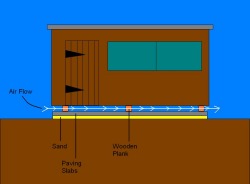Allotment Diary
Dig for Victory!
Dig for Victory!
JARGONBUSTER/INSTRUCTIONS
Right, we're confused. Here, we're going to try and explain the crazy sounding words that gardeners use.
Chitting
You know when you bought that massive bag of potatoes from the supermarket and then used one and forgot about the rest? And then you find them again a month later and they're a-l-i-v-e like scary aliens with tentacles? Thats Chitting, apparently. I call it 'freaky scary ewww in the bin you go'.
Spit
A Spit is the length of your spade's blade.
Dig-Over/Rotovate
Digging over or Rotovating means breaking down your soil to make it less clumpy and easier to work with. Grab your spade and dig a trench, basically turning your load into the hole you've just dug. Do as much as you fancy, then grab your fork and stab at the clumps for a while to break it down.
Double-Dig
Double Digging is where once you've dug over an area, you dig it over again. Start at one end, and dig down to a spade's depth (aka one 'spit') all the soil you dig out should be put behind you in a row. Then, dig again into the same trench another spade's depth (just the blade not the whole thing!). Work along the area in lines doing the same thing until you get to the end. You will then have double-dug your first veg plot! This makes it easier to plant in, circulates air and breaks up your soil if its compacted.
Fruit Tree 'Canes'
Much to my surprise, a young Rasberry bush (I just aquired some) looks like a twig with roots on the end. Just one long-ish stick with roots on. I guess a cane is more descriptive than bush at this stage.
Shedzilla

So, here is our plan for a shed, and how we're going to base it on our soggy ground, when we eventually get one. After levelling out the soil and treading over it to compact it we'll get a layer of sand the same size as our shed base (you can pick up sand from builders merchants - google again haha) and beg some paving slabs from J's dad.
The most important thing is air flow around your shed. If your shed sits straight onto the soil, moisture will seep up and be absorbed by the wood. This will eventually rot your precious shed. We need the sand and paving slabs to disperse the weight of the shed and its eventual contents, and to provide an even surface. Then we'll need some wooden planks the same width of your shed to rest it on. I've put three on the picture but we'll proabably need more depending on the eventual size.
The wooden planks will raise the shed off the ground and allow air flow underneath to keep it nice and dry. It will also provide a shelter for beneficial animals such as ladybirds, beetles and hedgehogs. Unfortunately, it will also be a haven for slugs and snails but oh well, where else are you going to put your spade, I ask you?
The most important thing is air flow around your shed. If your shed sits straight onto the soil, moisture will seep up and be absorbed by the wood. This will eventually rot your precious shed. We need the sand and paving slabs to disperse the weight of the shed and its eventual contents, and to provide an even surface. Then we'll need some wooden planks the same width of your shed to rest it on. I've put three on the picture but we'll proabably need more depending on the eventual size.
The wooden planks will raise the shed off the ground and allow air flow underneath to keep it nice and dry. It will also provide a shelter for beneficial animals such as ladybirds, beetles and hedgehogs. Unfortunately, it will also be a haven for slugs and snails but oh well, where else are you going to put your spade, I ask you?
